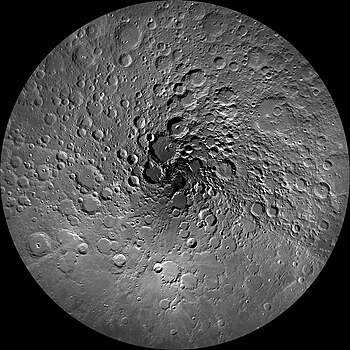Cosmic Journeys Episode 1: Birth of the Moon (HD)
Season 1
Scientists have been reconstructing the history of the moon by scouring its surface, mapping its mountains and craters, and probing its interior. What are they learning about our own planet's beginnings?
 |
| Full Moon view from earth In Belgium (Hamois) (Photo credit: Wikipedia) |
e great cold war struggle. Landing on the moon was a giant leap for mankind. But it's what the astronauts picked up from the lunar surface that may turn out to be Apollo's greatest legacy.
When the astronauts of Apollo stepped out of their landing craft, they entered a world draped in fine sticky dust, strewn with rocks, and pocked with craters. They walked and rambled about, picking up rocks that they packed for the return flight.
Back in earth-bound labs, scientists went to work probing the rocks for clues to one of the most vexing questions in all of science. Where did the moon come from? The answer promised to shed light on an even grander question. Where did Earth come from? And how did it evolve into the planet we know today?
The nature of the moon began to come into focus four centuries ago. Galileo Galilei had heard of an instrument built by Dutch opticians capable of "seeing faraway things as though nearby." Galileo, in many ways the first modern scientist, saw this new instrument as a tool to help settle a long standing question.
 |
| The Moon's north pole during summer. (Photo credit: Wikipedia) |
To some philosophers, the moon was a perfect, crystalline sphere of divine substance, free of Earth's imperfections. Galileo, with his telescope, saw a more familiar reality. He noted mountains and valleys on the moon, features like those of Earth.
The astronauts of Apollo lifted off on a series of missions to get a close up look at the moon and perhaps settle the debate. Because there's no atmosphere there, the astronauts entered landscapes that are nearly frozen in time. They could scour the lunar surface for evidence of events going back almost to the time of its birth.
Indeed, eons of impacts had opened up the Moon's interior, leaving a wealth of information strewn about their landing sites. Scientists had already noticed that some large old craters were surrounded by concentric rings. You can see one of the most pronounced examples in this image of the Mare Orientale, captured recently by NASA's Lunar Reconnaissance Orbiter, or LRO. The colors show differences in elevation.
The old view was that the impact had melted the rock below. A newer view held that the impactor had actually splashed down on a molten surface. That gave rise to the radical notion that, early in its history, the moon's surface was covered in a vast ocean of magma.
When the astronauts arrived, they found relatively light rocks known as anorthosites. Their presence suggested that heavier material had sunk toward the moon's interior, forcing lighter material to the surface.
The rocks they brought back were found to be strikingly similar to those on Earth, in part because they share forms of oxygen, called isotopes, that scientists regard as "blood types" for solar system bodies. Then there was this. The moon appeared to be completely, utterly, dry, with no evidence that water was ever present on its surface.
